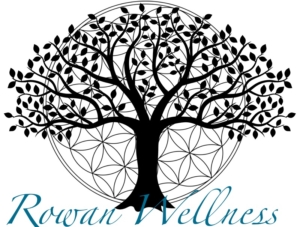THE MYTHOS OF THE LABYRINTH AND ITS APPLICABILITY TO MODERN SPIRITUAL LIFE
The labyrinth is an old structure of varying construction and complexity, but generally is circular in shape, with meandering paths that resemble, roughly, a spiral. Unlike a maze, which has dead-ends or false paths, a labyrinth has a single path to enter which ends in the center, with the same path traveled in reverse to exit. The term “labyrinth” dates back as early as 5th century BC, when the Greek writer and traveler Herodotus described an Egyptian labyrinth situated across from the City of Crocodiles. It has also appeared prominently in Greek Mythology via the poet Homer, when Daedalus and his son Icarus “invented” a labyrinth to trap and hold the Minotaur. Later, it was appropriated by Christians and used as a symbolic journey for those that could not travel to complete the pilgrimage to Jerusalem. Even today, many churches still host labyrinths on their grounds.
“The motif of the labyrinth has a long history. Depictions in rock art may date back as far as 10,500-4800 BCE, and can be found from Nevada to Cornwall, from Lancashire to Spain.“
DR KATY SOAR,
https://folklorethursday.com/folklore-of-archaeology/cretan-labyrinth-myth-history-archaeology/
Today, labyrinths are primarily used as a spiritual tool, whether as a walking meditation or for prayer. Symbolically, the labyrinth is said to represent the journey to the inner self, and the subsequent return to the outer world. My first real introduction to them was via my friend Anna, who had a long-held fascination with them and later built one on her land. When she came to visit me for my first wedding anniversary after my husband’s death, I wanted something different for us to do, something that held meaning. I found a list of local labyrinths and we chose a few to walk.
“The point of a maze it to find its centre. The point of a Labyrinth is to find YOUR centre.”
Author Unknown
I remember that the first labyrinth we walked had a cardinal, which my family associates with “visits” from my husband, sitting on a tree right at the edge, singing loudly. Perhaps that, as well as my wedding anniversary, opened me up to a very particular lesson. As my friend and I walked the labyrinth together, I noticed that it held so many messages related to my journey with my husband, and relationships in general. As we walked the paths, I found that my friend and I were occasionally very close to one another, and then a moment later at opposite ends of labyrinth. Sometimes we walked on adjacent paths going in the same direction, other times we were walking in opposite. And no matter how closely we walked one behind the other, it was impossible for us to both arrive at the center at the exact same moment, although we could choose to wait for the other in that sacred center.
Later that night, we decided on the spur of a moment, after a large dinner with friends at my husband’s and my favorite restaurant, to return to the labyrinth, all five friends walking the paths together. The lessons above were reflected in an even deeper sense, namely that it’s impossible for us to walk the same paths at the exact same time. Occasionally we walked in tandem, sometimes in opposition, sometimes close together in the labyrinth, sometimes far apart on opposite ends. Sometimes someone stopped for a moment to reflect and another would have to scoot around them on the narrow path. One friend insisted on walking across the paths rather than following them, which drove another friend to distraction. Mostly we alternated moments of quiet reflection with uproarious laughter, and finally we gathered in the center together, arriving singly, but waiting there together in beautiful unity.
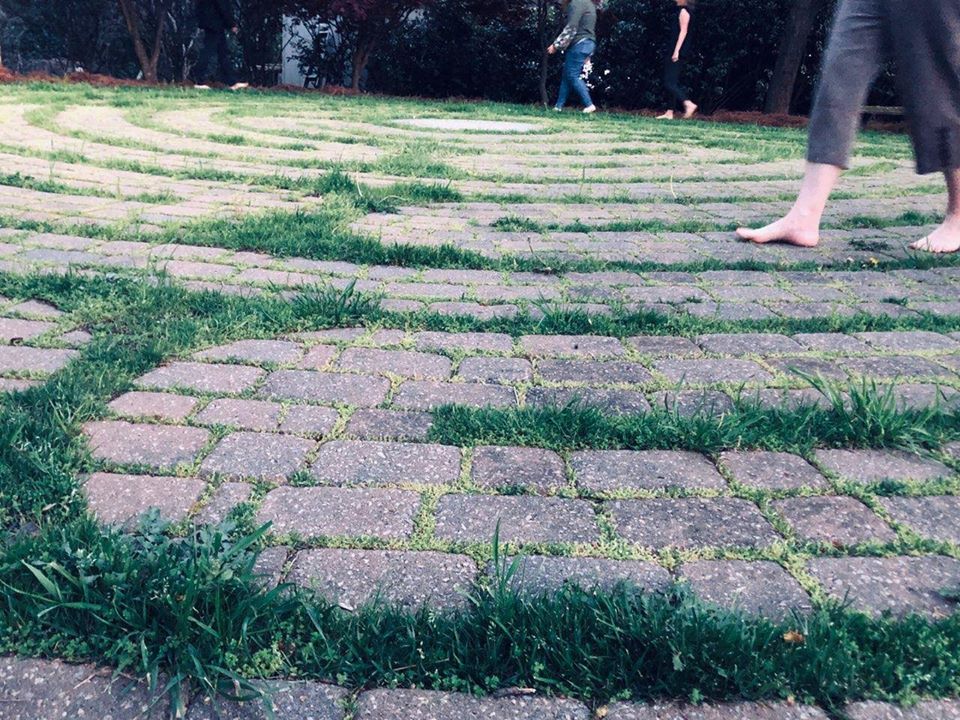
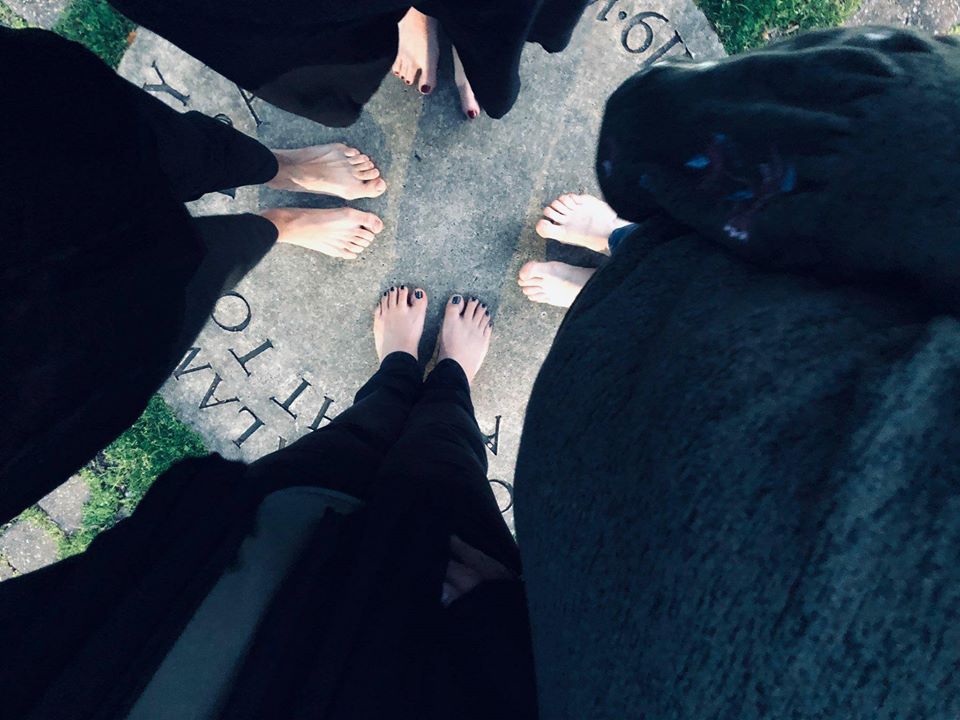
In the almost year since that day we walked together, I’ve only visited any of the local labyrinths perhaps a handful of times, but they are often on my mind. I’ve walked an approximation of the them on my land in ceremony, and my friend and I talk often about me constructing one here on my land, and then linking ours together energetically (as hers is linked energetically to another friend’s.) We envision a network of labyrinths, linked together in harmony and power, and in which we can meditate in synch. Recently, in working with someone on a shamanic journey, the labyrinth came into play as a wonderfully powerful initiatory and closing location, inside which the journeyer felt safe, empowered, energized and psychically clear.
For me, the impetus to construct my own labyrinth has become stronger and more imperative. There are many considerations including pattern (of which there are many), location, and materials that allow for easy maintenance. I decided, because it’s been awhile since I last walked a labyrinth, to visit one of the local labyrinths, new to me, to see if I might gain some clarity. Below are the notes and insights from my visit.
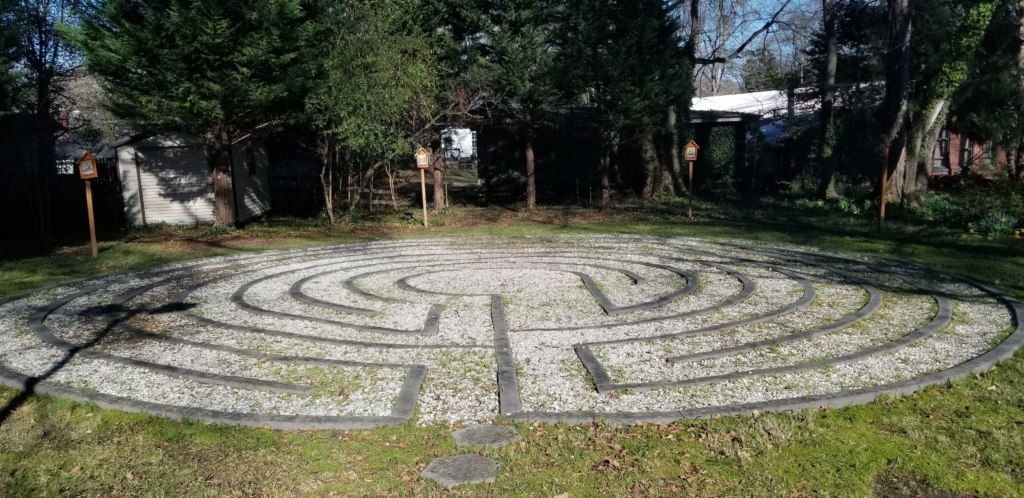
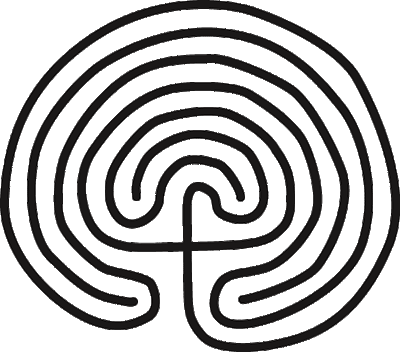
“…It makes me cry, I want to talk about something I am not sure I can talk about, I want to talk about the inside from the inside, I do not want to leave it. I am so happy in the silky damp dark of the labyrinth and there is no thread”
― Hélène Cixous, The Book of Promethea
When I arrived, I said a small prayer before entering, “Let the wisdom of the labyrinth be known to me. May I be clear and open enough to receive it. May I be humble enough to understand it. May I be strong enough to integrate it and then pass it on.” On my first entrance onto the path, I noticed immediately that I entered on an intermediate circle, which wound progressively outwards to the outer circle, then back to an intermediate path, then circumventing the center (but not arriving at it), moving outward again, and then arriving, quite unexpectedly, in the center. (I would encourage you to trace with your finger the 2-dimensional depiction above for yourself so that you can actually visualize what’s happening.) I wrote:
We are born, we enter at the mid-point, where the inner and outer worlds are evenly matched. But we are quickly taken outward; the ego grows. Larger, larger. Suddenly there is a contraction to the inner, the essence of the self, of truth. Very close to the center but cannot enter, not yet. Taken back out into expansion, where inner and outward are equal, in balance. Suddenly, we are at the center, at the essence, the TRUTH.
Another similar note:
There is process of constant movement: Balance – Expansion – (Re)Balance – Contraction – (Re)Balance.
Later, there’s a specific point of the labyrinth that seemed to trigger a particular response from me on each pass:
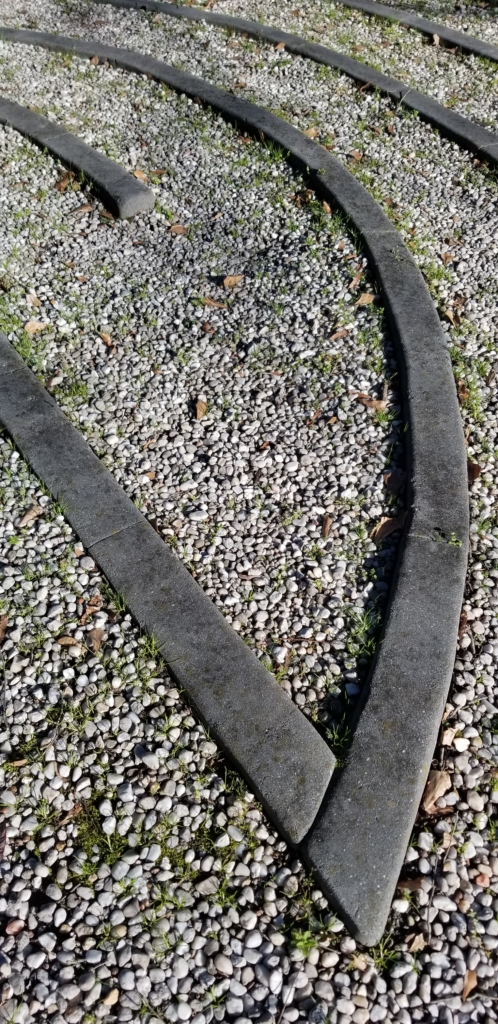
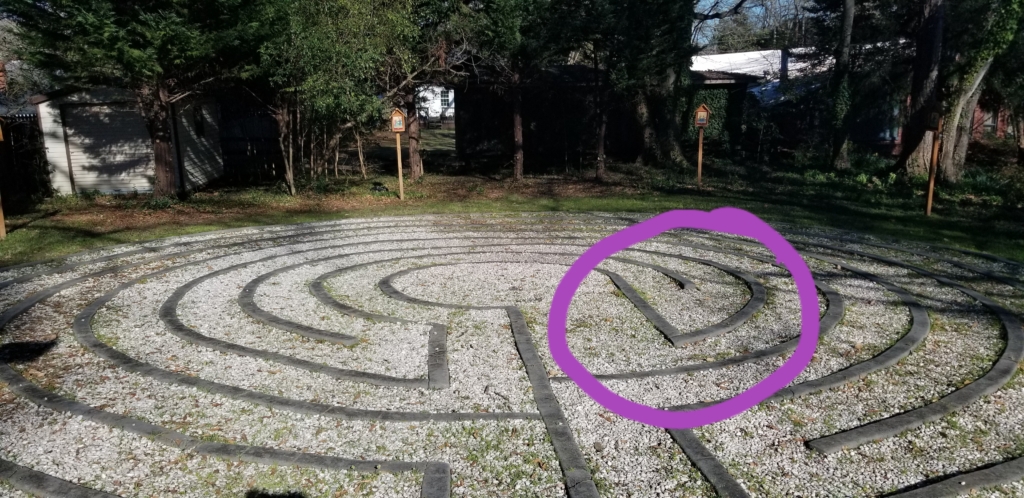
In regards to this particularly tight turn, I wrote this:
You are so close to the center, so close to the truth. But then there’s an uncomfortable, painful turn, and you are carried away from the center, sent further out than you care to be. You can’t help but to be lost in your thoughts during that circuit; distracted. How did it get away? It was so close. And then without warning, you’re there. One turn and you’re in the center, in the core of your ESSENCE, and TRUTH.
I made a total of seven passes through the labyrinth, often sitting in the center for some moments to seek guidance and messages. On one, I was told, “Remember who you are. Your strength, your wisdom, your gentleness, your wholeness.” On another, I was instructed to pick up a rock while in the center. I, without deliberately choosing, picked up the white rock on the left in the picture below. I exited the labyrinth and was instructed to pick up another rock from the entrance area. I, again without deliberate thought, “happened” to choose the rough, dirty, oddly shaped rock on the right. If we consider that the labyrinth represents the self, with the outer rings representing our human soul, the inner circle representing our spirit, or innate essence, it’s fantastic to see how the rocks appear to reflect or symbolize this: our human selves are often rougher, dirty, and somewhat oddly cumbersome. Our inner selves, however, are beautiful, smooth and polished. Both, however, are sturdy, useful objects, both made of the same materials.
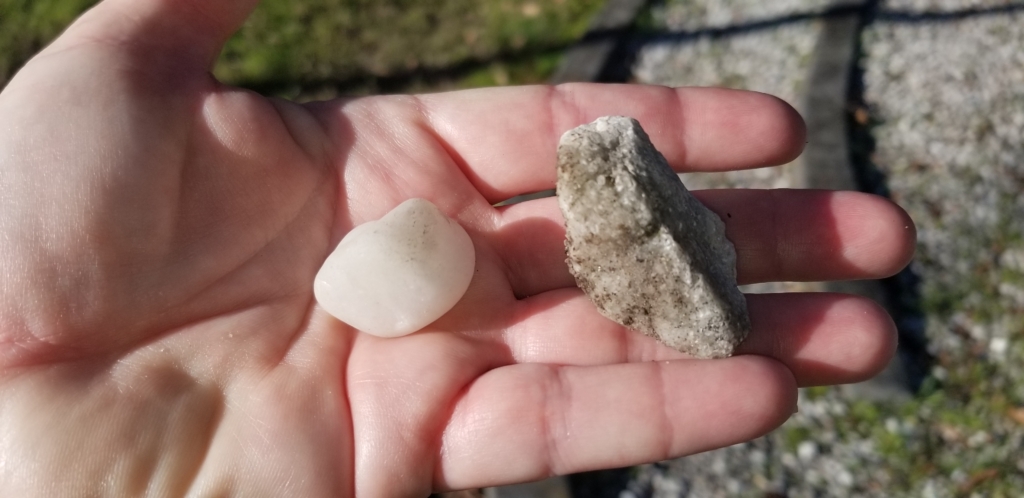
Some other interesting insights from my day. Time in the labyrinth seemed to pass slowly. I noticed several times that my thinking, time-driven mind, kept getting impatient, saying, “This is taking soooo long, for me to get to the center, and then back out.” Because you never seem to be in the labyrinth where it seems like you should be! Rather resembling, for me at least, the passing of time, and events, during life. Another thing I noticed is that, because the paths were gravel, the faster I walked, the more I seemed to struggle because the rocks kept shifting beneath my feet. My journey was much simpler and more stable, the slower and more deliberately I walked. For me, the lesson reflected in these thoughts is this: the less we rush in life, the less we focus on where we think we should be, and focus instead on the next step, taken with consciousness, the more pleasant, productive, and stable our lives become.
Some other interesting things that happened; about halfway through, sometime during my 3rd or 4th trips, beautiful bells started sounding somewhere on the church grounds. During my fifth pass, an event must have started at the church. Suddenly, what had up to that point been quiet, started to build with car doors slamming, people walking past, in ones and twos to start, but later a large progression as the group moved from one building to another. A very private, introvert by nature, I had the inclination to stop and leave. But, feeling strongly that seven was the number of cycles I needed to complete, I ignored the distraction of all the people and continued walking the path. We must walk our path even when others are observing, even if uncomfortable in being witnessed.
Another interesting event rather resembling the tight, uncomfortable turn I talked about above; on my sixth (next to last) trip through, a neighbor to the church let their dog outside. It heard me walking the path and went absolutely bonkers. The entire trip through was loud with the dog barking and it felt chaotic and decidedly UN-meditative, as the dog was obviously upset by my near presence. This lasted the entire 6th pass. As I exited the labyrinth, the owner took the dog back inside and suddenly all was quiet and peaceful once again. I found it so curious that another example manifested of the “chaos before arrival;” just as with the turn above, just as I was so close to the end, it all seemed to become uncomfortable. But on that final lap, as I arrived at the conclusion, it settled back into place.
Finally, on that last trip, as I was exiting and on the very outer ring, I suddenly heard, for just a few moments, loud and extremely beautiful Gregorian Chanting. It was so sudden and unexpected that I literally stood stock still on the path listening, even after it stopped, hoping that it would resume again. (It didn’t.) What a magical note (no pun intended) to end on!
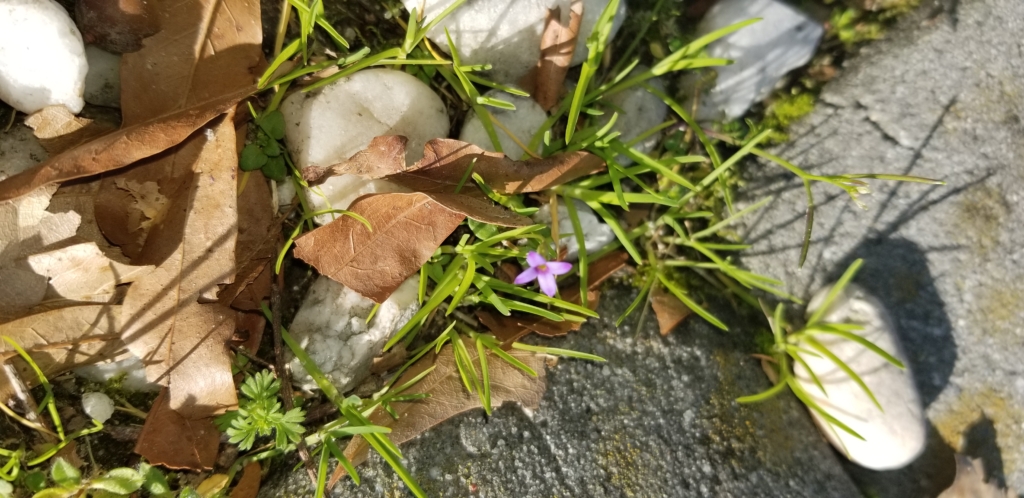
If you have a labyrinth near you, I encourage you to check it out sometime. It’s a wonderfully peaceful, enlightening experience. If you’ve already had the experience, I’d love to hear more (via comments below)!
